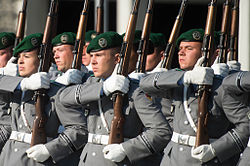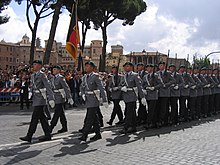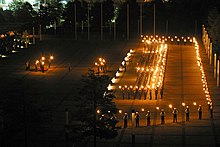
In military organizations, a colour guard is a detachment of soldiers assigned to the protection of regimental colours and the national flag. This duty is highly prestigious, and the military colour is generally carried by a young officer (ensign), while experienced non-commissioned officers are assigned to the protection of the national flag. These non-commissioned officers, accompanied in several countries by warrant officers, can be ceremonially armed with either sabres or rifles to protect the colour. Colour guards are generally dismounted, but there are also mounted colour guard formations as well.

The Karabiner 98 kurz, often abbreviated Karabiner 98k, Kar98k or K98k and also sometimes incorrectly referred to as a K98, is a bolt-action rifle chambered for the 7.92×57mm Mauser cartridge. It was adopted on 21 June 1935 as the standard service rifle by the German Wehrmacht. It was one of the final developments in the long line of Mauser military rifles.

Jäger is a German military term referring to specific light infantry units.

The Bundeswehr is the armed forces of the Federal Republic of Germany. The Bundeswehr is divided into a military part and a civil part, the military part consisting of the German Army, the German Navy, the German Air Force, the Joint Support Service, the Joint Medical Service, and the Cyber and Information Domain Service.
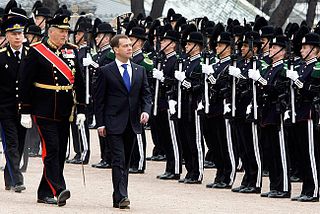
In some militaries, foot guards are senior infantry regiments. Foot guards are commonly responsible for guarding royal families or other state leaders, and they also often perform ceremonial duties accordingly, but at the same time are combat soldiers.

Gebirgsjäger are the light infantry part of the alpine or mountain troops (Gebirgstruppe) of Germany, Austria, and Switzerland. The word Jäger is a characteristic term used for light infantry in German speaking countries.

The Felix Dzerzhinsky Guards Regiment was the paramilitary wing of the Ministry for State Security (Stasi), the security service of the German Democratic Republic (GDR).

The Federal Ministry of Defence, abbreviated BMVg, is a top-level federal agency, headed by the Federal Minister of Defence as a member of the Cabinet of Germany. The ministry is headquartered at the Hardthöhe district in Bonn and has a second office in the Bendlerblock building in Berlin, which is occasionally used as a metonym to denote the entire Ministry.
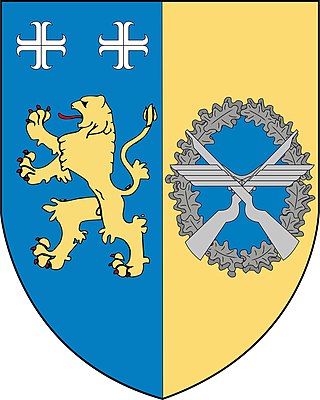
The German Air Force Regiment “Friesland” is a ground-based regiment-sized branch of the German Air Force (Luftwaffe) with its main bases in Diepholz and Schortens. However, in the future this regiment will be located at Jever Air Base.
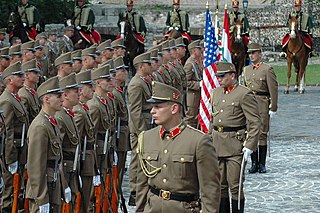
A guard of honour, honor guard or ceremonial guard, is a group of people, typically drawn from the military, appointed to perform ceremonial duties – for example, to receive or guard a head of state or other dignitaries, the fallen in war, or to attend at state ceremonials, especially funerals. In military weddings, especially those of commissioned officers, a guard, composed usually of service members of the same branch, form the sabre arch. In principle, any military unit could act as a guard of honour. In some countries, certain units are specially assigned to undertake guard of honour postings or other public duties. Republican guards, royal guards and foot guards frequently have ceremonial duties assigned to them.

The Großer Zapfenstreich is a military ceremony performed in Germany and Austria. It is similar to the military tattoo ceremony performed in English-speaking countries, and is the most important ceremonial act executed by the German federal armed forces, the Bundeswehr, and by the Austrian federal armed forces Bundesheer. The Zapfenstreich is performed only during national celebrations and solemn public commemorations, to honour distinguished persons present at such special events. Examples are the farewell ceremony for a German federal president, or at the conclusion of large military exercises. It takes place in the evening hours and consists of a military formation of at least one military band, two platoons of armed infantrymen, and two lines of soldiers carrying torches, in total about 400 men.

The Feldgendarmerie were a type of military police units of the armies of the Kingdom of Saxony, the German Empire and Nazi Germany until the conclusion of World War II in Europe.
The red beret is a military beret worn by many military police, paramilitary, commando, and police forces and should not be confused with the maroon beret worn by airborne troops all around the world.
The evolution of German military rifles is a history of common and diverse paths followed by the separate German states, until the mid-19th century when Prussia emerged as the dominant state within Germany and the nation was unified. This article discusses rifled shoulder arms developed in or for the military of the states that later became Germany; it excludes firearms of the Austrian Empire, except where they were used substantially by German troops.

Schützen is a German plural noun used to designate a type of military unit of infantrymen, originally armed with a rifled musket and used in a light-infantry or skirmishing role – and hence similar to the Jäger. The individual infantrymen are termed Schütze. Prior to the introduction of firearms the word was used for 'archer', and is sometimes used in the form Bogenschütze.

Infantry Regiment 9 of Potsdam was an infantry regiment in Weimar Republic's Reichswehr and Nazi Germany's Wehrmacht, descended from famed 1st Prussian Regiment of Foot Guards in the German Empire's Deutsches Reichsheer. Garrisoned at the cradle of Prussian army and rich with tradition, it was nicknamed 'Count Nine' or 'I.R. von 9' by its detractors because of high percentage of Prussian aristocrats and purported arrogance in its ranks.

Troops began wearing berets as a part of the headgear of military uniforms in some European countries during the 19th century; since the mid-20th century, they have become a component of the uniforms of many armed forces throughout the world. Military berets are usually pushed to the right to free the shoulder that bears the rifle on most soldiers, but the armies of some countries, mostly within Europe, South America, and Asia, have influenced the push to the left.

The Kommando Territoriale Aufgaben der Bundeswehr short (KdoTerrAufgBw) "Bundeswehr Territorial Tasks Command" of the Bundeswehr is based in the Julius-Leber- Kaserne (Barracks) in Berlin-Wedding was founded in 2013 and is in charge of all territorial tasks of the forces as well as for the support of the civil administration.
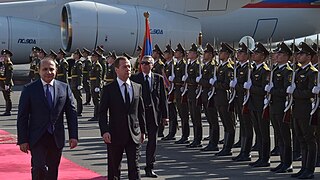
The Honour Guard Company of the Ministry of Defence of Armenia is a military unit of Armed Forces of Armenia that performs protocol tasks for high-ranking officials at the Presidential Palace and the Prime Minister's Residence. The unit is under direct command of the Ministry of Defence of Armenia. Most members of the unit are graduates of the Vazgen Sargsyan Military University.

The Gardebataillon is a ceremonial unit in the Austrian Armed Forces. The Gardebataillon is one of the most important military units in the Austrian Armed Forces as its main task is to represent Austria at home and abroad. It is stationed exclusively at Maria Theresien Barracks in Vienna.
